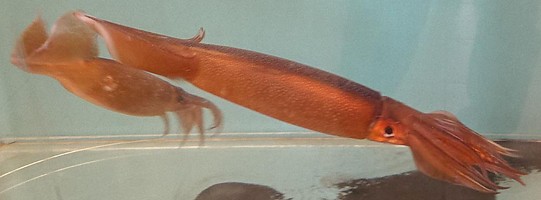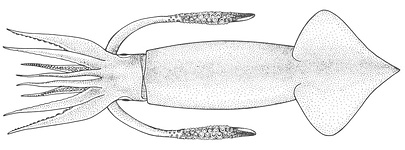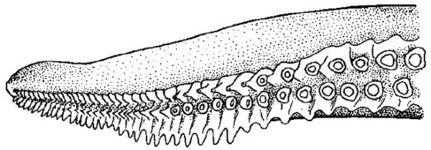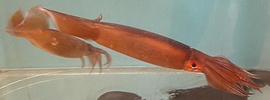Todarodes pacificus
Richard E. YoungIntroduction
Todarodes pacificus is one of the most abundant of the commercially valuable squid in the world and occupies waters of the eastern North Atlantic. Commonly reaches 300 mm ML off Japan (Roper, et al., 2010).Characteristics
- Arms
- Right arm IV hectocotylized. Distal third modified (see drawing).
- Largrest arm suckers with 9-11 pointed teeth on distal 2/3 of ring.
- Right arm IV hectocotylized. Distal third modified (see drawing).
- Tentacles
- Club small, narrow.
- Largest club suckers with 16-20 subequal teeth on rings.
- Carpus with 8-11 small, nearly uniform suckers in oblique rows with: 1, 3, 4; 2,3, 4; 3, 4, 4 or 1, 2, 3, 4 suckers.
- Manus with about 40 suckers in 4 series, two medial sucker series about 3 times diameter of marginal suckers.
- Dactylus with about 70 suckers in 4 series.
 Click on an image to view larger version & data in a new window
Click on an image to view larger version & data in a new window
Figure. Oral view of the tentacular club of T. pacificus, 255 mm ML, showing the alignment of suckers in the carpal region. Drawing from Sasaki (1929).
- Club small, narrow.
Distribution
Type locality: off Hakodate, Japan. Occurs primarily in the far eastern North Pacific including the Sea of Okhotsk, Sea of Japan and the East China Sea. A map of its distribution can be found here.References
Dunning, M. C. 1998. Ommastrephidae. In: Carpenter, K. E., Niem, V. H. (eds.). FAO species identification guide for fishery purposes. The living marine resources of the Western Central Pacific. Vol. 2. Cephalopods, crustaceans, holothurians and sharks. FAO, Rome. p. 687-1396.
Roper, C.F.E., Nigmatullin C. & and Jereb P. 2010. Family Ommastrephidae. In P. Jereb & C.F.E. Roper, eds. Cephalopods of the world. An annotated and illustrated catalogue of species known to date. Volume 2. Myopsid and Oegopsid Squids. FAO Species Catalogue for Fishery Purposes. No. 4, Vol. 2. Rome, FAO. pp. 269–347.
Sasaki, M. 1929. A Monograph of the Dibranchiate Cephalopods of the Japanese and Adjacent Waters. Journal of the College of Agriculture, Hokkaido Imperial University, 20(supplement):357 pages.
Title Illustrations

| Scientific Name | Todarodes pacificus |
|---|---|
| Location | Hokkaido Univ., Hakkodate, Japan |
| Comments | Squid swimming in small holding tank. |
| Specimen Condition | Live Specimen |
| View | Side |
| Image Use |
 This media file is licensed under the Creative Commons Attribution-NonCommercial License - Version 3.0. This media file is licensed under the Creative Commons Attribution-NonCommercial License - Version 3.0.
|
| Copyright |
©
Michael Vecchione

|
About This Page
Richard E. Young

University of Hawaii, Honolulu, HI, USA
Correspondence regarding this page should be directed to Richard E. Young at
dickphyllisyoung@gmail.com
Page copyright © 2018 Richard E. Young
 Page: Tree of Life
Todarodes pacificus .
Authored by
Richard E. Young.
The TEXT of this page is licensed under the
Creative Commons Attribution-NonCommercial License - Version 3.0. Note that images and other media
featured on this page are each governed by their own license, and they may or may not be available
for reuse. Click on an image or a media link to access the media data window, which provides the
relevant licensing information. For the general terms and conditions of ToL material reuse and
redistribution, please see the Tree of Life Copyright
Policies.
Page: Tree of Life
Todarodes pacificus .
Authored by
Richard E. Young.
The TEXT of this page is licensed under the
Creative Commons Attribution-NonCommercial License - Version 3.0. Note that images and other media
featured on this page are each governed by their own license, and they may or may not be available
for reuse. Click on an image or a media link to access the media data window, which provides the
relevant licensing information. For the general terms and conditions of ToL material reuse and
redistribution, please see the Tree of Life Copyright
Policies.
- First online 30 November 2011
- Content changed 20 February 2018
Citing this page:
Young, Richard E. 2018. Todarodes pacificus . Version 20 February 2018 (under construction). http://tolweb.org/Todarodes_pacificus/77454/2018.02.20 in The Tree of Life Web Project, http://tolweb.org/












 Go to quick links
Go to quick search
Go to navigation for this section of the ToL site
Go to detailed links for the ToL site
Go to quick links
Go to quick search
Go to navigation for this section of the ToL site
Go to detailed links for the ToL site